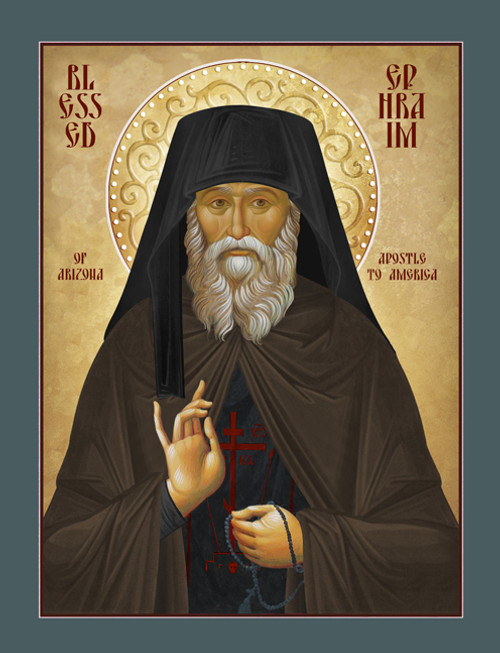Asia Minor, the birthplace of saints such as St. Basil the Great, St. Gregory the Theologian, St. Gregory Palamas, St. Irene Chrysovalantou and so many others known and unknown, was also the birthplace of Maria Vassopoulou who was to become the spiritually renowned Gerontissa Makrina. The year she was born, 1921, was the year before the Great Catastrophe in Asia Minor where over 1.5 million Greeks were massacred by Turkish insurgents. The mass exodus of those Greeks who escaped the 1922 death march, the burning of Smyrna, and the expulsion of the Greek presence from Asia Minor led Maria’s parents to return to Greece with their 6-month-old infant. They settled in the refugee camp of Nea Ionia in Volos. Conditions in the camp were very harsh and Maria was forced to give up elementary school where she excelled, and instead, studied Scriptures and the writings of the Holy Fathers of the Church.
At the age of 7, she received the monastic calling when a divine transformation touched her heart while she was at play. The desire to reach God was so overwhelming that she ran home in tears before the icons in her home. Sobbing, she told her mother she wanted to become a nun, when she had never seen nor heard of monasticism. Her parents understood it was a calling from God. A year later, her father had a vision from God on his impending death, with the death of Maria’s mother to follow within a year. Both deaths came to pass leaving Maria and her 4-year-old brother George orphans.
The bitter years of an orphan made life very difficult. The two orphans were surrounded by starvation and death. While neighbors tried to help as much as they could, at the age of 9, Maria was forced to work in the house of a wealthy family and to hold other jobs. Once, when she was working as a housemaid, she became acquainted with the hieromonk Father Ephraim Karagiannis who was from the brotherhood of Elder Joseph the Hesychast. Through him, Maria learned the prayer of the heart and said it unceasingly at her various jobs. As their poverty worsened, Maria sent her brother away to be taken care of by an uncle near Thessaloniki while she remained alone, struggling to survive. During those difficult years, Maria was befriended by Victoria Moraitis (the mother of the future Geronta Ephraim). They shared the same spiritual father, prayed together, and Victoria would send food to Maria through her son, Johnny (Geronta Ephraim’s name before he was tonsured).
Through her spiritual father, Maria became acquainted with a young women who became her spiritual sisters and with whom she attended services and made spiritual pilgrimages. Once when they were lighting oil lamps in the small chapel of St. Nicholas of Kremastou, they were hungry and Maria wished they had some bread to eat with figs. When Maria went to light the oil lamp on the Holy Altar, she saw a package and it contained slices of bread and a fig for each girl. A month later at that same chapel, Maria saw blood and water running from the immaculate side of Christ on the Crucifix icon. She wiped some of the blood with cotton and took it to her spiritual father who announced that this was a sign that war was near. Shortly thereafter, WWII broke out.
Despite the hardships of the German-Italian Occupation of Greece, Maria never neglected her spiritual work or attending church. She continued to self-sacrifice to help others. She suffered bouts of severe illness and starvation and because of her intense love and devotion to Christ and Panagia, she was graced with many visions and miracles that encouraged her to persevere. The war ended and years passed while Maria and her spiritual sisters lived in the world as nuns. They struggled ascetically, fasted, held vigils, made thousands of prostrations and attended services together.
Throughout this time, Maria maintained regular correspondence with the Elder Joseph the Hesychast. In 1954, Maria and her spiritual sisters decided to find a temporary place to live together. In a letter, the Elder Joseph said they would find it near Volos and proceeded to describe in detail how they would find this specific place where they would begin their monastic life together. For seven years, Elder Joseph served as the spiritual guide for the sisterhood until his repose. Maria remained working in the world to fulfill the years required to earn a pension for the future sustainability of the sisterhood. Three years later, at the age of 36, Maria joined the sisters and shortly thereafter, her friend Victoria Moraitis came. The time had come to select an abbess to whom the sisterhood could show obedience. The Elder Joseph prayed and God revealed Maria. Out of her deep humility, Maria resisted but in a dream God showed her His will. She saw St. John the Forerunner ascending toward heaven and she followed him, gathering around her nuns. He turned and handed her the staff he was carrying. After this vision, Maria accepted her position.
Approaching the end of his life, Elder Joseph handed the spiritual guidance of the sisterhood to the future Geronta Ephraim. And in 1962, a piece of property was purchased in the village of Portaria which is now the site of the Monastery of Panagia Odigitria. In 1963, Geronta Ephraim tonsured his mother Victoria, giving her the name of Theophano and, shortly thereafter, tonsured Maria giving her the name Makrina after St. Makrina, the sister of St. Basil the Great. Gerontissa Makrina was endowed with many virtues which came forth from her Christ-centered life. She was renowned for her warm hospitality and charity. She supported many who were suffering and in need. She would constantly counsel her sisterhood on acts of charity. She was the epitome of humility, considering herself the least of all the sisters in her synodia (sisterhood). Thousands of men and women, bishops, hieromonks, gerontas and gerontissas of other monasteries such as the famous Geronta Iakovos Tsalikis from Evia, Geronta Iosif from Vatopedi, Geronta Gabriel of Makrynitsa, and monks and nuns from all over Greece flocked to Portaria, seeking the spiritual counsel of Gerontissa Makrina, whose wisdom and love for all imparted a spirit of peace to those who met her.
The end came on June 4th, 1995, after battling lung and heart conditions. She expressed to the Sisterhood that Gerontissa Taxiarchia was coming for her. Gerontissa Taxiarchia was her spiritual child and formerly a nun in the Sisterhood until she left for America to become the 1st Abbess of the Nativity of the Theotokos Monastery and had reposed a year earlier. Under Gerontissa Makrina’s guidance, her monastery in Volos became the source of many other monasteries that were established in Greece, America, and Canada.







